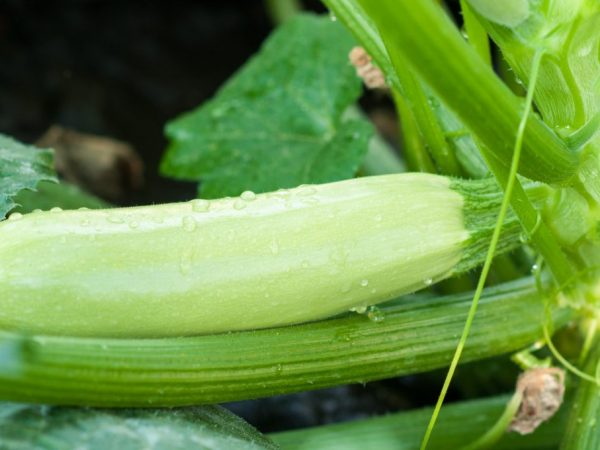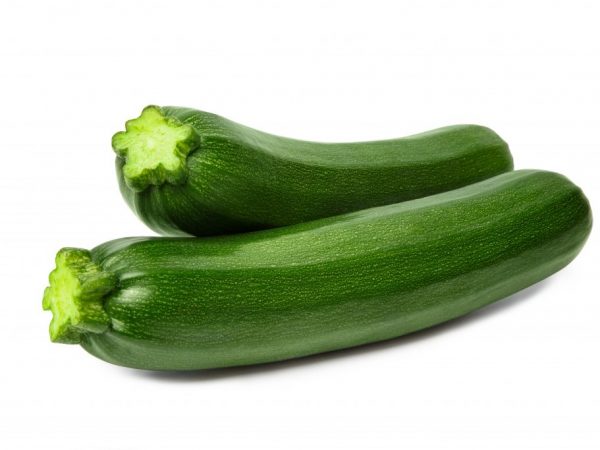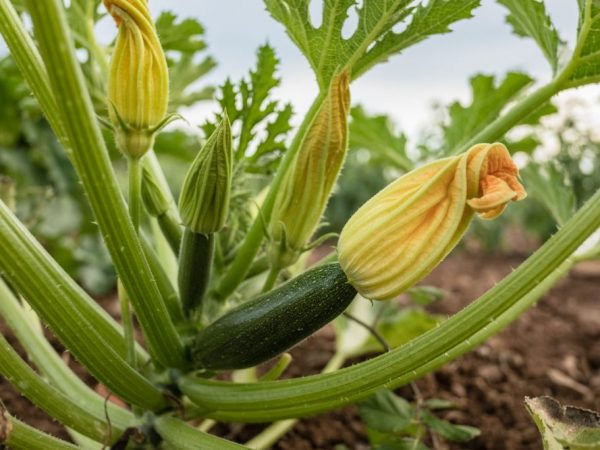Sizes and properties of zucchini
Zucchini is a classic representative of the pumpkin family. It is a bushy variety of hard-bore gourd from northern Mexico and is believed to be home to the Oaxaca Valley. Zucchini sizes vary. It is rich in micro and macro elements useful for human health, has good gastronomic qualities and is applicable in cooking.

Sizes and properties of zucchini
Botanical characteristic
Zucchini is a vegetable, not a fruit or berry. It does not grow on a tree, but is an annual pumpkin plant. It is a melon crop. Most plants have a bushy form, there are no whips, but some hybrids are characterized by a climbing ability similar to a pumpkin with creeping stems.
The stem is thickened, faceted in shape, erect, varieties with a lodging stem are found. The root system is strong, well developed, consists of a taproot and branched lateral root processes.
Initially, only squash seeds were eaten. The history of acquaintance with the vegetable of Europeans began in the 16th century, when they began to grow it in botanical gardens for decorative purposes. Italians were the first to start using zucchini in cooking.
The foliage is usually large, but there are varieties with small to medium leaves. They are green in color. The leaves are five-lobed, covered with a thorny and hard downy, sometimes with a slight whitish tint.
Inflorescences are large, monoecious. They are bell-shaped. Their color is bright yellow or orange. There are varieties of zucchini with male and female flowers or only one of the species. In male inflorescences, the pedicel is longer than in female.
A common type of zucchini is zucchini. It is a green-fruited vegetable with a high content of ascorbic acid. According to the description, it looks like a small zucchini and has rugged foliage with a silvery tint.
The fruits are oblong. The color of the peel is varied and directly depends on the variety of zucchini: it can be of all shades of green, yellow, creamy white and even black. There are bicolor specimens, striped or spotted. The relief of the peel also depends on the variety: there are smooth, lumpy and ribbed fruits.
One plant usually produces up to 18-20 vegetables.
The pulp is tender and juicy in structure. Its density depends on the variety and the ripening period of the fruit: in young specimens it is less dense, in adults it is much denser, in overgrown ones it is tough, like a peel. The color is different, but light shades - white, yellowish, cream.
For culinary purposes, it is better to use small fruits that have reached technical maturity - 7-10 days old. They have a special, delicate taste.
The shape of vegetables also varies. There are varieties with elongated cylindrical, oval, clavate, round and curved fruits. Inside them are seeds that are shaped like sunflower seeds. They are flat, elongated, white or cream, small in size. 1 thous.zucchini seeds weigh about 130-150 g.
Benefit and harm

Zucchini contains many useful elements.
The calorie content of a vegetable crop is on average 27 kcal per 100 g. Its composition is rich in elements useful for human health. Zucchini contains potassium, iron, magnesium, phosphorus, organic acids, fiber, vitamins C, PP, B1, B2, B6, carotene. The product is easily digested and does not cause heaviness in the stomach.
Benefit
Zucchini is recommended for consumption:
- with problems in the work of the cardiovascular system;
- with stagnation of bile and to restore glycogen in the liver;
- to protect the mucous membranes of the stomach and intestines, acting as a prevention of ulcers and other diseases of the gastrointestinal tract;
- as a remedy for getting rid of worms: seeds are an anthelmintic agent;
- to combat puffiness;
- as prevention of prostate diseases in men;
- to maintain high calcium levels in pregnant women;
- against excessive accumulation of cholesterol;
- as a means that activates the process of digestion and helps to accelerate the assimilation of "heavy" food.
Harm
With its undoubted benefits for the human body, zucchini can harm those who have any health problems. So, among the contraindications for including it in the diet:
- kidney disease;
- high acid content in the gastrointestinal tract;
- excess potassium (hyperkalemia).
Application
Zucchini is mainly used in cooking. Its pulp is tender, cooks quickly, and the product itself tastes well with other vegetables, meat and fish. It can be used both raw in salads and thermally processed in first and second courses.
Very often, zucchini can be found in Mediterranean cuisine, the most famous of which is ratatouille. Residents of French Provence love stuffed squash flowers.
Young zucchini have high gastronomic characteristics and delicate taste, are easily digested by the human gastrointestinal tract. The vegetable is added to the diet of children, patients for the recovery period after surgery or a serious illness, suffering from digestive problems.
The low calorie content of squash and its fast absorption have made it popular in diets.
Quality indicators
According to the GOST in force in Russia, all zucchini are divided into the highest, 1st and 2nd grades. At the same time, basic requirements are imposed on them:
- freshness of the fruit;
- no signs of pest damage and integrity violations;
- technical ripeness;
- uncoarse and unfading peel;
- smooth or ribbed surface, depending on the variety;
- the presence of a peduncle;
- lack of foreign odors and taste;
- juiciness and sufficient density of the pulp, the absence of voids;
- sizes up to 16 cm and weight up to 225 g for the premium grade, length up to 26 cm and weight up to 600 g for the first, size up to 35 cm and no weight limit for the second.
For the third, fodder, grade, defects in shape, color, traces of sunburn and mechanical damage are permissible in the absence of violations of the integrity of the pulp.
The cost
The price of vegetables varies depending on the season and region of sale. So, the average of the minimum prices for zucchini in the markets and in supermarkets in Russia at retail by month is for 1 kg:
- August - from 43 rubles;
- September - from 68 rubles;
- November - from 88 rubles;
- December - from 125 rubles;
- January - from 145 rubles.
Zucchini in animal feeding
A vegetable that has reached biological maturity and has lost its taste is more often used not for human consumption, but for feeding livestock.
Culture is especially useful:
- cattle (cows, goats), because zucchini are quickly digested in their stomach, acting as a milk-producing natural remedy, enriching cattle meat products with a high content of potassium and calcium;
- piglets and rabbits, they are given fresh vegetables in small quantities, diluting the feed ration to balance the nutrition and supply the necessary elements required in the process of growth and development.
As a variety of the feed menu, the vegetable should be given to turkeys and chickens. Dogs include zucchini in their diet mainly in boiled form instead of cereals, because it goes well with meat and offal.
For domestic animals and livestock, juicy zucchini has considerable nutritional value, is well absorbed by them and promotes the digestion of basic feed. However, it is worth limiting its amount in the feed ration, because the vegetable has a laxative effect.
Growing

Zucchini are not very whimsical to care for
Zucchini is grown on an industrial scale and in private household farms, outdoors and in a greenhouse. You can cultivate a vegetable crop by seed or seedling, while in the southern regions it is permissible to plant with seeds, and for the northern regions it is recommended to pre-germinate seedlings.
Usually, plants tolerate low temperatures well, are unpretentious in care, love moisture and, subject to the basic rules of agricultural technology, are rarely damaged by diseases and pests.
Soil requirements
Soil will be suitable for growing zucchini, in which there are:
- turf;
- peat;
- rotted manure;
- rotted sawdust;
- coarse river sand.
Instead of self-preparation of the land, it is permissible to use purchased mixtures intended for growing pumpkin seeds.
The soil in the garden is prepared in the fall, adding manure or chicken droppings during digging. For culture, a soil with neutral acidity is preferable. In the spring, before sowing seeds or transplanting seedlings, the ridges are dug up and additionally humus or compost is added.
The best "predecessors" for vegetable crops are potatoes, cabbage, beans, onions and garlic. You should not plant zucchini in the garden after peppers, carrots and eggplants.
The fertility of the soil and its acidity are regulated by the introduction of wood ash, limestone, sawdust. The exception is manure, which raises the temperature of the soil layer and can lead to overheating of the roots. Disinfect the soil with a weak solution of potassium permanganate.
Landing
When sowing zucchini with seeds, preparatory work (pre-sowing processing of seed material) begins in April, 20-30 before the expected date of transplanting seedlings to the garden.
Landing scheme
Usually, zucchini are planted according to the scheme 0.8 x 0.8 m, where the digital indicators are the distance between rows and between bushes. In the southern regions, vegetables are often sown with ribbons according to the scheme 0.9 x 0.5 x 0.7 m, where 0.9 is the distance between the ribbons, 0.5 is between the rows, and 0.7 is between the bushes.
The seeds are buried 5-7 cm into loose soil and 3-5 cm into dense soil.
Care
Vegetable culture tolerates short-term drops in temperature to 5-6 ° C, however, cooling to 0 ° C stops its growth and leads to death. The optimum temperature for zucchini is considered to be 20-25 ° C.
In the process of growing, the plants are fed. Usually this is done when seedlings appear, then - during the formation of inflorescences, at the stage of active flowering, and top dressing is completed during the fruiting period.
At the initial stage of growth and development, seedlings require nitrogen, potassium and phosphorus, and during flowering nitrogen-containing dressings are excluded so as not to cause an intensive build-up of green mass. Let's allow watering and foliar spraying.
Fertilization scheme:
- the first feeding falls on the 8-10th day after the mass emergence of seedlings, the culture is fed with superphosphate (2 g is diluted in 1 liter of water) or with potassium permanganate (a weak solution is made);
- subsequent fertilizing is carried out at intervals of 7-10 days, watering and spraying zucchini with bird droppings diluted with water (1:20), slurry (1:15), alternating them with the introduction of mineral complexes;
- at the flowering stage, the vegetable is usually fertilized with nitrophos (1 tbsp. l) and mullein (0.5 l), diluted in water (10 l);
- at the beginning of fruiting, it is recommended to add wood ash (2 tablespoons per 10 liters of water).
Zucchini are moisture-loving plants, but they are able to cope with short-term drought. It is recommended to water them with water at room temperature in the evening 1-2 times every 7 days. The consumption of liquid before the formation of ovaries is 10 liters, at the fruiting stage - 12-15 liters per 1 bush.
When watering, avoid water ingress on foliage and stems. Its optimum temperature is 22 ° C.
The main enemies that infect squash plantings are spider mites, sprout flies, and melon aphids.
Maturation
The beginning of the fruiting stage in zucchini depends on the variety and varies from 35 to 60 days after sowing the seeds:
- ultra-early ripening ones give the first harvest in 35-40 days;
- early ripening ripen on 40-45 days;
- in mid-season vegetables appear 46-50 days after sowing the seeds;
- late-ripening fruits bear fruit starting from the 50th day.
On the 7-10th day after the formation of fruits, the technical maturity of vegetables begins. Such young specimens 15-30 cm long and 4-10 cm in diameter are suitable for food purposes and have the most delicate pulp.
Full biological maturity occurs after 100-120 days. By this time, vegetables become tasteless, lose their beneficial properties and are suitable only for feeding animals.
Zucchini in the wild
Zucchini has long been a cultivated plant, so it does not grow in the wild.
If such a vegetable is found outside the household, then, most likely, this is a representative of an ordinary variety that has fallen into the wild with wind streams, insects, animals or birds.
The largest zucchini in the world
The average weight of a vegetable is 0.3 to 1.5 kg. At the stage of technical ripeness, the size of the zucchini varies from 15 to 30 cm.At the onset of biological maturity, they grow up to 1-1.5 m.
However, there are giant vegetables gaining weight up to 30 kg. These varieties include Russian size, a large fruit of which grows up to 1.5 m in length.
In 1998, an Englishman from Chesterfield, John Handbury, raised a record-breaking vegetable on his plot. His zucchini weighed 61.23 kg.
This record was broken by Australian gardener Ken Dade, who grew a vegetable weighing 65 kg on his plot, thanks to which he became famous all over the world, being in the Guinness Book of Records in 2008.

